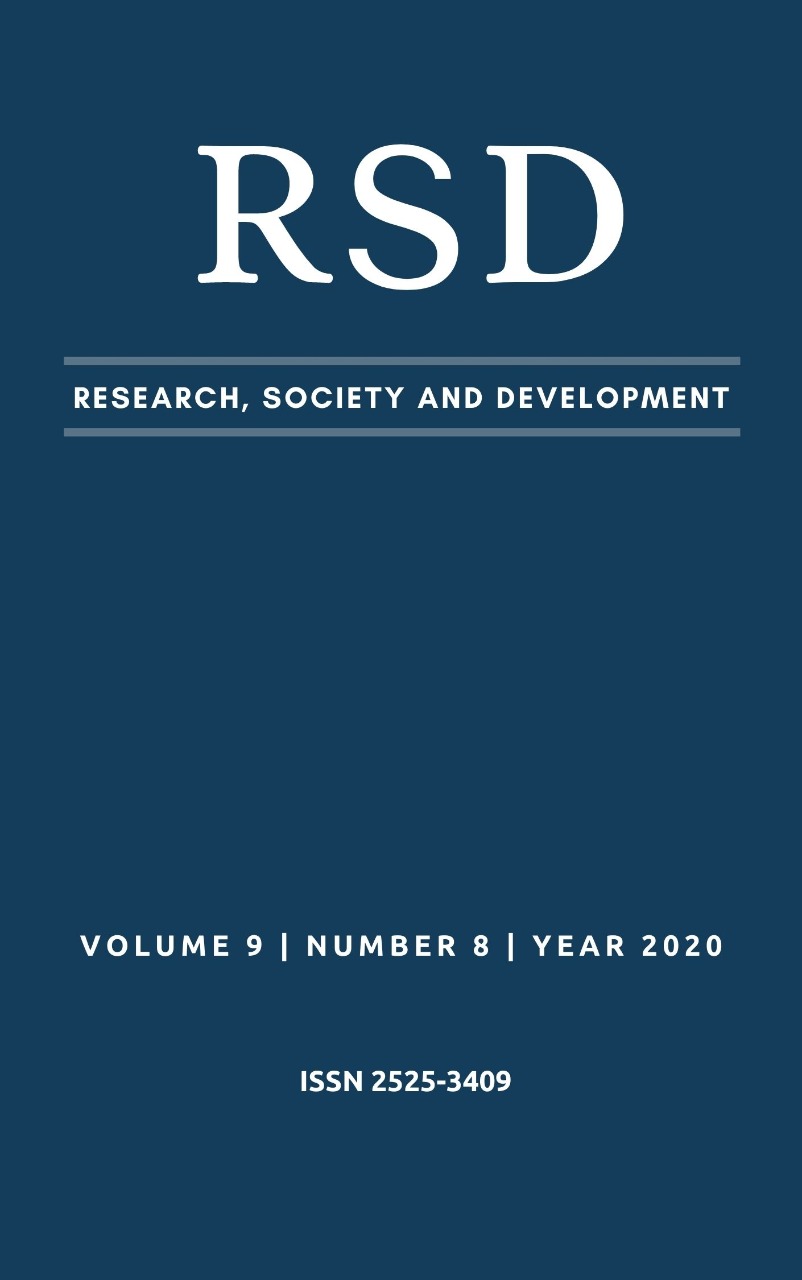Dynamic Incremental Model (MDI) to forecast the SARS-CoV-2 pandemic stabilization period
DOI:
https://doi.org/10.33448/rsd-v9i8.6201Palavras-chave:
COVID-19; Dynamic Model; Prediction; Deaths.Resumo
Since the beginning of the year 2020, the world has been experiencing a COVID-19 pandemic, which challenges the public sector to make quick and efficient decisions, as the result is counted in lives. Thus, it is necessary to search for predictive models that support the decision and assist in the understanding of the behavior of the transmissions. In this context, the work aims to present a dynamic model for the daily increase in the number of deaths in order to determine a safety range capable of predicting a stabilization period for these deaths. For this, the model uses exponential and potential curves as limits for analyzing the behavior of the increment curve. The model proved to be efficient when compared to the actual data obtained so far.
Referências
Alfani, G., & Murphy, T. E. (2017). Plague and lethal epidemics in the pre-industrial world. the Journal of economic History, 77(1), 314-343.
Anderson, R. M., & May, R. M. (1991). Infectious diseases of humans. 1991. New York: Oxford Science Publication Google Scholar.
Araz, O. M., Choi, T. M., Olson, D. L., & Salman, F. S. (2020). Role of Analytics for Operational Risk Management in the Era of Big Data. Decision Sciences.
Assunção, C. S. L. T. Assunção, M. V. D., Sousa, M. C. M., & Oliveira, R. A. A. (2020). A relational study between government decrees and number of deaths by COVID-19 in Northeastern Brazil. Research, Society and Development, 9 (8), 1-20.
Bastos, S. B., & Cajueiro, D. O. (2020). Modeling and forecasting the Covid-19 pandemic in Brazil. arXiv preprint arXiv:2003.14288.
Botari, T., Alves, S. G., & Leonel, E. D. (2011). Explaining the high number of infected people by dengue in Rio de Janeiro in 2008 using a susceptible-infective-recovered model. Physical Review E, 83(3), 037101.
Brasil (2020). Ministério da Saúde. Boletins epidemiológicos diários. Brasília/DF.
Cruz, A. R. (2011). Uma metodologia multiobjetivo para o controle de epidemias através de vacinação impulsiva via algoritmo genético com operador de busca local baseado em aproximação quadrática convexa e validação estocástica.
Ghosal, S., Sengupta, S., Majumder, M., & Sinha, B. (2020). Prediction of the number of deaths in India due to SARS-CoV-2 at 5–6 weeks. Diabetes & Metabolic Syndrome: Clinical Research & Reviews.
Ivanov, D. (2020). Predicting the impacts of epidemic outbreaks on global supply chains: A simulation-based analysis on the coronavirus outbreak (COVID-19/SARS-CoV-2) case. Transportation Research Part E: Logistics and Transportation Review, 136, 101922.
Kermack, W. O., & McKendrick, A. G. (1927). A contribution to the mathematical theory of epidemics. Proceedings of the royal society of london. Series A, Containing papers of a mathematical and physical character, 115(772), 700-721.
Liang, K. (2020). Mathematical model of infection kinetics and its analysis for COVID-19, SARS and MERS. Infection, Genetics and Evolution, 104306.
Lipsitch, M., Swerdlow, D. L., & Finelli, L. (2020). Defining the epidemiology of Covid-19—studies needed. New England journal of medicine, 382(13), 1194-1196.
Mace, R. (2000). Evolutionary ecology of human life history. Animal behaviour, 59(1), 1-10.
Montesinos-Lopez, O. A., & Hernandez-Suarez, C. M. (2007). Mathematical models for infectious diseases. Salud publica de Mexico, 49(3), 218-226.
Moura, U. A. S., & Rocha, R. L. (2012). Endemias e epidemias: dengue, leishmaniose, febre amarela, influenza, febre maculosa e leptospirose. Belo Horizonte: Nescon/UFMG.
Organização Mundial de Saúde. The global burden of disease: 2004 update. Geneva: World Health Organization, 2008.
Organização Mundial de Saúde. Visão Geral do coronavirus. Disponível em: < https://www.who.int/health-topics/coronavirus>. Acesso em: 26/04/2020.
Qin, L., Sun, Q., Wang, Y., Wu, K. F., Chen, M., Shia, B. C., & Wu, S. Y. (2020). Prediction of number of cases of 2019 novel coronavirus (COVID-19) using social media search index. International journal of environmental research and public health, 17(7), 2365.
Senhoras, E. M. (2020). Coronavírus e o papel das pandemias na história humana. Boletim de Conjuntura (BOCA), 1(1), 31-34.
Temime, L., Hejblum, G., Setbon, M., & Valleron, A. J. (2008). The rising impact of mathematical modelling in epidemiology: antibiotic resistance research as a case study. Epidemiology & Infection, 136(3), 289-298.
Vasconcelos, G. L., Macêdo, A. M., Ospina, R., Almeida, F. A., Duarte-Filho, G. C., Brum, A. A., & Souza, I. C. (2020). Modelling fatality curves of COVID-19 and the effectiveness of intervention strategies. PeerJ, 8, e9421.
Walker P, Whittaker C, Watson O, Baguelin M, Ainslie K, Bhatia S et al (2020). Report 12: The global impact of COVID-19 and strategies for mitigation and suppression. London: Imperial College; 2020.
Wang, H., Wang, Z., Dong, Y., Chang, R., Xu, C., Yu, X., ... & Wang, Y. (2020). Phase-adjusted estimation of the number of coronavirus disease 2019 cases in Wuhan, China. Cell discovery, 6(1), 1-8.
Zu, Z. Y., Jiang, M. D., Xu, P. P., Chen, W., Ni, Q. Q., Lu, G. M., & Zhang, L. J. (2020). Coronavirus disease 2019 (COVID-19): a perspective from China. Radiology, 200490.
Downloads
Publicado
Como Citar
Edição
Seção
Licença
Copyright (c) 2020 Marcus Vinicius Dantas de Assunção, Carla Simone de Lima Teixeira Assuncao, Rute Anadila Amorim Oliveira, Mariah Caroline Martins de Sousa

Este trabalho está licenciado sob uma licença Creative Commons Attribution 4.0 International License.
Autores que publicam nesta revista concordam com os seguintes termos:
1) Autores mantém os direitos autorais e concedem à revista o direito de primeira publicação, com o trabalho simultaneamente licenciado sob a Licença Creative Commons Attribution que permite o compartilhamento do trabalho com reconhecimento da autoria e publicação inicial nesta revista.
2) Autores têm autorização para assumir contratos adicionais separadamente, para distribuição não-exclusiva da versão do trabalho publicada nesta revista (ex.: publicar em repositório institucional ou como capítulo de livro), com reconhecimento de autoria e publicação inicial nesta revista.
3) Autores têm permissão e são estimulados a publicar e distribuir seu trabalho online (ex.: em repositórios institucionais ou na sua página pessoal) a qualquer ponto antes ou durante o processo editorial, já que isso pode gerar alterações produtivas, bem como aumentar o impacto e a citação do trabalho publicado.

